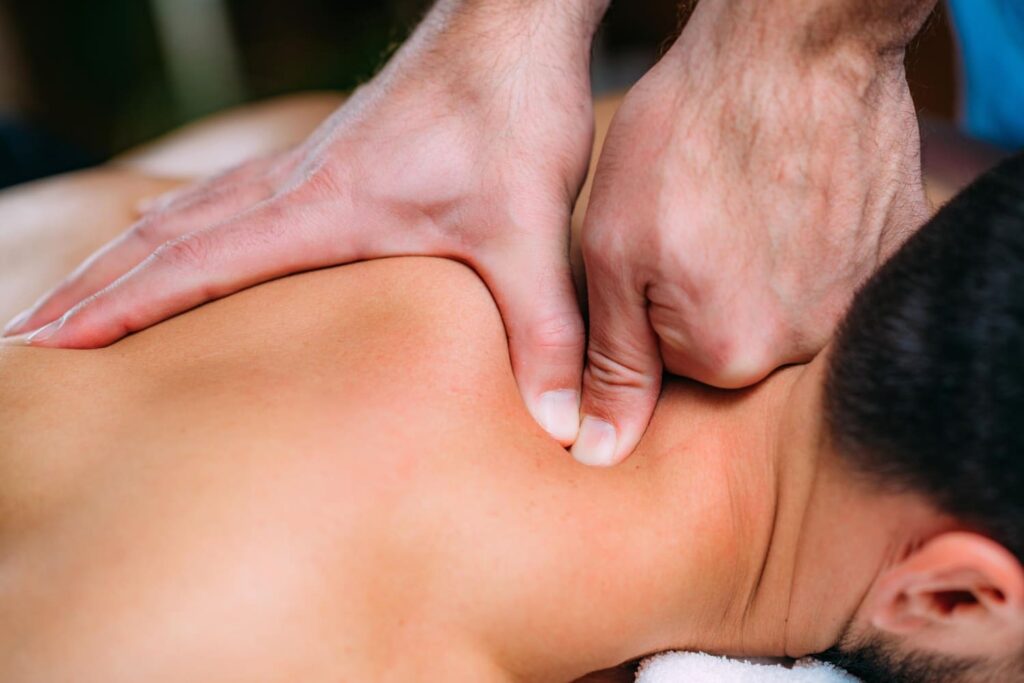Feeling muscle pain, tension, or stiffness? That may be a sign of a trigger point—and trigger point therapy may be what you need the most. This massage type targets specific areas where the pain originates, resulting in pain relief after each session.
Interested in trying this massage? Don’t live in pain; check out how this massage therapy can benefit you!
What is Trigger Point Therapy?

Trigger point therapy involves treating hyperirritable spots, known as trigger points, within the taut bands of skeletal muscles’ fascia.
These points can cause local tenderness, referred pain, and a characteristic jump sign when pressure is applied. It’s especially beneficial for those with tightness due to physical trauma, scarring, inflammation, compressed nerves, or repetitive stress injuries.
What Causes Trigger Points?


Tensed muscles, dehydration, weakness, small tears, and even poor diet are potential causes of trigger points.
The overworked or injured muscle fibers that can’t relax cause mini contractions in small areas of the fascia or muscle. These knots of contracted tissue restrict blood flow, depriving the muscle of oxygen and leading to waste buildup.
As a result, the pain from trigger points discourages movement, causing more trigger points to develop.
What Can Trigger Point Therapy Treat?


A trigger point is not the only one a trigger point therapy can treat. Some other treatable conditions are:
- Sciatica
- Elbow pain
- Muscle tightness
- Headaches and migraines
- Heel pain
- Sporting injuries
- Shoulder and knee conditions
- Back pain
- Numbness and pins and needles
- Temporomandibular joint pain
Benefits of Trigger Point Therapy


Trigger point therapy brings various benefits, making it a good alternative for treating muscle pain and similar cases. Here are some of the benefits:
Reduced Stress and Tension
This therapy helps reduce stress, which contributes to muscle tension. As a result, you will get the ultimate relaxation experience.
Higher Energy Levels
Tense muscle is draining as your body needs to work harder to deliver what is usually considered normal effort, resulting in lower energy levels. This therapy helps release the tense muscles and, eventually, boost your energy level.
Pain Relief From A Headache
Neck pain is often the result of tense muscles. If you leave this condition untreated for a long time, you will inevitably feel a headache. Trigger point therapy can help relieve headaches by releasing muscle tension and reducing pain signals sent to the brain.
Better Circulation
Trigger point therapy can improve circulation by releasing tightness in affected areas. It promotes better blood flow, delivering nutrients and oxygen to muscles and nerves and reducing stiffness and tension caused by poor circulation.
Increased Mobility and Flexibility
Muscle stiffness and pain limit your mobility and flexibility, resulting in more restricted daily activities. Trigger point therapy helps relax these muscle problems and, as a result, boost mobility and flexibility.
Better Sleep
If you’re having trouble sleeping due to muscle pain, try out the trigger point therapy. This therapy helps release contracted muscles, which elevate discomfort during sleeping.
Methods of Trigger Point Therapy


Several methods are available for trigger point therapy, including:
Manual Therapy for Trigger Points
For this method, therapists usually focus on the trigger point and apply sustained pressure until it is released. They will first locate the tight nodule within the muscle band. Upon locating, they will press on the trigger point until you feel it release. This can take 30 seconds to a few minutes. Multiple sessions may be needed for chronic trigger points.
Massage equipment like a ball can also help release trigger points. This method temporarily restricts blood flow, allowing it to rush back, bringing nutrients to the area.
Myofascial Dry Needling
This method uses an acupuncture needle inserted into the trigger point of the muscle. It elicits a twitch response, causing the muscle to contract and relax.
Some benefits of this method include helping eliminate muscle tension, desensitizing the nervous system to trigger point pain, and increasing blood flow, which attracts nutrients to the area.
Frequently Asked Questions
Is trigger point therapy right for everyone? Are there any conditions where it might not be recommended?
Trigger point therapy is generally safe, but it’s not recommended for individuals with certain conditions such as open wounds, active infections, recent surgery, severe osteoporosis, bleeding disorders, or those on anticoagulants.
What can I expect during a trigger point therapy session?
During a trigger point therapy session, pressure is applied to specific points in the body to release tight muscles, contractions, and knots. These areas, known as trigger points, can cause pain and discomfort. When pressure is applied to the trigger point, it helps reduce muscle tension and improves the range of motion.
How long does it typically take to see results from trigger point therapy?
Results from trigger point therapy can typically be felt within a few sessions, often showing clear improvement within a week and sometimes even in just a day or two.
Conclusion
Trigger point therapy is an excellent alternative for those with muscle stiffness, tension, or pain. This targeted therapy focuses on one specific area, helping release the pain and dysfunction straight from its root.
If you’re interested in getting yourself a trigger point therapy session, visit Chada Thai Massage. Our therapists will help you get the ultimate relaxation experience and leave our place pain-free!
